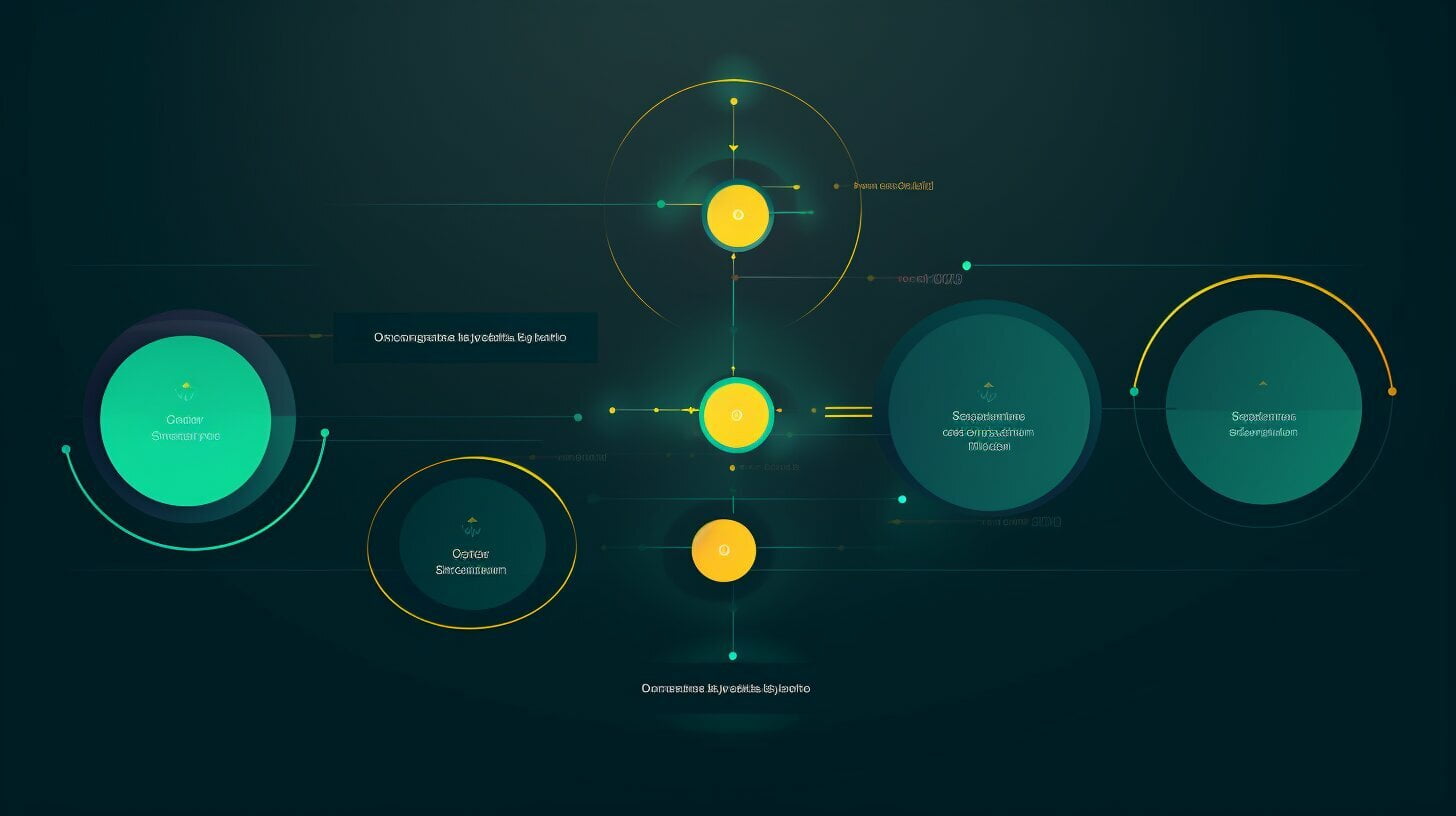
In the world of IT, deployment patterns play a critical role in achieving seamless and efficient application releases. These patterns are essential for managing risk, minimizing downtime, and enabling controlled feature releases. Some of the commonly used deployment patterns include Blue-Green, Canary, Rolling, Feature Toggles, A/B testing, and Dark launches.
Each pattern has its unique characteristics and advantages, which makes it important for IT professionals to understand and leverage the right patterns for their organization’s needs. In this article, we will provide an in-depth overview of these deployment patterns, explore their benefits, and discuss best practices for successful implementation.
Key Takeaways:
- Blue-Green, Canary, Rolling, Feature Toggles, A/B testing, and Dark launches are all deployment patterns.
- Each pattern has unique characteristics and advantages.
- IT professionals must understand and leverage the right patterns for their organization’s needs.
- In this article, we will provide an in-depth overview of these deployment patterns, explore their benefits, and discuss best practices for successful implementation.
Blue-Green Deployment
Blue-Green deployment is a popular deployment strategy that enables organizations to deploy applications with minimal downtime. The concept of Blue-Green deployment is to have two identical environments, one production environment, and one identical environment that acts as a replacement. The production environment is represented by the color blue, while the identical environment is represented by the color green.
The benefits of Blue-Green deployment are numerous. Since the updated version of the app is deployed in the green environment, it can be tested without affecting the stability of the currently deployed production environment. Once the green environment is thoroughly tested, traffic can be diverted from the blue environment to the green environment, making the new version live. If any issues occur, traffic can be immediately redirected back to the blue environment, ensuring that users are not impacted.
Best practices for Blue-Green deployment include maintaining identical environments, automating deployment, testing the green environment, and monitoring performance metrics. Real-world examples of organizations that use Blue-Green deployment include Microsoft, Amazon, and Netflix, among others.
Real-world Example: Amazon’s Blue-Green Deployment
“Amazon uses Blue-Green deployment for updating its retail applications. With this process, Amazon can deploy new releases with zero downtime and carefully test features before they go live. Their Blue-Green deployment also allows for faster rollbacks and improves the reliability of their services.”
Canary Deployment
Canary deployment is a deployment pattern that involves gradually releasing a new version of an application to a subset of users or servers. This allows for testing the new version in a live environment while minimizing the impact on the overall system. Canary deployments are commonly used for critical or high-traffic applications.
The purpose of canary deployment is to detect issues and performance problems before releasing the new version to the entire user base. By testing the new version in a controlled environment, developers can monitor its behavior and ensure that it is stable and reliable.
One advantage of canary deployment is that it enables a faster release cycle. By releasing the new version to a subset of users, developers can collect feedback and make improvements more quickly. They can also reduce the risk of downtime or rollbacks by catching issues early.
When implementing canary deployment, it is important to have a strategy for monitoring and rollback. Developers should establish metrics and alerts to detect problems in the canary environment and have a plan in place for rolling back if necessary.
Overall, canary deployment is a valuable tool for managing application releases, particularly for critical or high-traffic applications. By gradually releasing new versions and monitoring their behavior, developers can ensure that their applications are stable, reliable, and responsive to user feedback.
Rolling Deployment
Rolling deployment is a deployment pattern that involves gradually replacing old instances of an application with new ones. Unlike Blue-Green and Canary deployments, there are no separate environments in rolling deployment. Instead, new versions of the app are deployed to a limited number of servers, while old versions continue to run on others. This allows for a controlled, gradual rollout.
One advantage of rolling deployment is that it reduces the risk of downtime or errors as the new version is gradually rolled out. However, it can also be more complex to implement, especially for large applications with many instances. Proper testing and monitoring are critical to the success of a rolling deployment.
When implementing rolling deployment, it is important to consider the order in which instances are updated, as well as the impact of the new version on other dependent systems. Careful planning and coordination are essential to minimize disruptions and ensure a smooth transition.
Benefits of Rolling Deployment
Rolling deployment offers several benefits:
- Gradual rollout: New versions of the app are rolled out gradually, reducing the risk of downtime or errors.
- Control: The deployment process can be controlled and monitored closely to minimize risk and ensure a smooth transition.
- Fast rollback: If an issue arises, it is easy to roll back to the previous version.
Considerations for Rolling Deployment
When implementing rolling deployment, it is important to consider the following:
- Testing: Proper testing is essential before and during the rollout to ensure the new version is functioning correctly.
- Monitoring: Monitoring the deployment closely is critical to detect and address issues quickly.
- Dependency management: Consider the impact of the new version on other dependent systems to avoid disruptions.
- Order of deployment: Decide on the order in which instances will be updated to minimize disruptions and ensure a smooth transition.
Feature Toggles
Feature toggles, also known as feature flags, are an essential part of deployment patterns. They enable controlled feature releases, allowing developers to turn features on or off based on various conditions. Feature toggles come in different types, including boolean, percentage, and release date toggles, each serving a specific purpose.
One of the key benefits of feature toggles is their ability to reduce risk during deployments. By toggling off features that may cause issues, developers can avoid potential downtime and negative impacts on users. Additionally, feature toggles facilitate easy rollback if a new feature causes unexpected problems.
Managing feature toggles effectively is crucial for their success. Developers should ensure proper documentation, communication, and testing of all toggles. Furthermore, it is important to have a clear strategy for toggling off old features and toggling on new ones, to prevent feature bloat and maintain a streamlined codebase.
A/B Testing
A/B testing is a powerful technique used to test and optimize deployment strategies. It involves comparing two versions of a product or service to determine which one performs better. This method is used to test different variables, such as design, copy, and functionality, to make data-driven decisions.
The purpose of A/B testing is to identify the best performing version of a product or service. In the context of deployment patterns, A/B testing can be used to compare different feature releases or deployment strategies. This method can help organizations make informed decisions that improve user experience and increase engagement.
Successful A/B testing requires careful planning and execution. It is important to define clear objectives, determine the appropriate sample size, and set relevant success metrics. Data analysis and interpretation are also critical to drawing meaningful conclusions from the results.
- Define clear objectives
- Determine appropriate sample size
- Set relevant success metrics
- Perform data analysis and interpretation
“A/B testing is a powerful method for optimizing deployment strategies and improving user experience.”
When implementing A/B testing, it is important to consider ethical considerations and user privacy. Organizations should obtain informed consent from users, ensure that data is anonymized, and be transparent about data collection and usage.
A/B testing can be highly effective when integrated into deployment strategies. By testing and optimizing different variables, organizations can achieve better performance, engagement, and user satisfaction.
Dark Launches
Dark launches are an increasingly popular deployment pattern that enables controlled release of new features to a subset of users without affecting the overall application performance. This approach allows developers to test new features in production without affecting the overall application performance or risking negative user experience.
Dark launches work by releasing new features to a small group of users, usually internal users or a select group of beta testers. The feature is released within the application codebase but is turned off by default.
Once the developers are confident that the new feature is stable and performs as intended, they can gradually roll it out to all users by enabling the feature flag. This approach allows for a smooth and risk-free feature release, reducing the likelihood of errors or bugs that could result in downtime or poor user experience.
Dark launches are particularly useful for highly complex applications or long-term projects, where feature releases need to be carefully managed and tested. They provide a more reliable testing environment than traditional testing methods, as they enable developers to test the new feature in real-world scenarios without exposing it to all users.
Combining Deployment Patterns
While Blue-Green, Canary, Rolling, Feature Toggles, A/B testing, and Dark launches are powerful deployment patterns on their own, combining them can create even more effective strategies. Using a combination of deployment patterns can enhance control, speed, and reliability during the release process.
Combining Rolling and Canary Deployments
Rolling and Canary deployments can be used together to ensure a smooth release and monitor how new features affect system performance. Rolling deployment can be used to deploy the new code to a subset of servers, while Canary deployment can be used to release the new feature to a subset of users on these servers. This allows for a controlled release of new features while minimizing risk and ensuring gradual adoption.
Combining Blue-Green and Feature Toggles
Blue-Green deployments can be combined with feature toggles to enable even more control over feature releases. Feature toggles can be used to enable or disable features on the blue and green environment separately, allowing for more fine-grained control over the release process. This also enables the ability to roll back quickly if issues arise.
Combining Dark Launches with A/B Testing
Dark launches and A/B testing can be used together to test new features in production without exposing them to all users. A dark launch can be used to release a new feature to a subset of users, while A/B testing can be used to compare the performance of the new feature against the existing one. This allows for data-driven decision making and ensures that new features are thoroughly tested before being released to all users.
Combining deployment patterns can have huge benefits, but it is essential to carefully plan and test the combined strategy to ensure that it works effectively.
Challenges and Considerations
While deployment patterns offer many benefits, implementing them successfully comes with its own set of challenges. IT professionals need to consider several factors to ensure a smooth deployment process. Here are some of the challenges and considerations when using deployment patterns:
Infrastructure Complexity
Application infrastructure can be complex, comprising multiple layers and configurations. Deploying changes across different environments can lead to configuration drift, making it challenging to ensure consistency. To overcome this challenge:
- Create a comprehensive inventory of infrastructure and application dependencies
- Deploy changes sequentially across environments, starting with the least critical ones
- Use automation tools to ensure consistent configuration across environments
Testing and Monitoring
Testing and monitoring are critical aspects of successful deployments. However, they can be challenging when using deployment patterns. Here are some considerations:
- Develop testing strategies that align with the deployment pattern, such as canary testing for Canary deployments
- Implement monitoring tools to detect issues and enable quick rollback
- Create alerts to notify teams of issues and ensure prompt response
Communication and Collaboration
Deploying changes across multiple teams and departments can be challenging, requiring effective communication and collaboration. Here are some considerations:
- Ensure all stakeholders understand the deployment pattern and its benefits
- Define clear roles and responsibilities for each team
- Facilitate communication channels and establish regular check-ins
By addressing these challenges and considerations, IT professionals can implement deployment patterns successfully and realize their benefits.
Best Practices
Implementing deployment patterns can be complex, but following best practices can ensure a smoother process. Here are some industry-proven best practices for deploying Blue-Green, Canary, Rolling, Feature Toggles, A/B testing, and Dark launches:
Testing
Test your deployment patterns thoroughly before release. This includes unit testing, integration testing, and end-to-end testing. Use automation tools to streamline testing and reduce errors.
Monitoring
Monitor your applications closely during and after deployment. Use monitoring tools to track performance, detect errors, and gather user feedback. This will help you identify issues early and make necessary adjustments.
Communication
Communicate effectively within your team and with stakeholders. Establish clear communication channels, provide regular updates, and set expectations. This will help avoid misunderstandings and ensure everyone is aligned on the deployment process.
Rollback Strategy
Have a rollback strategy in place in case of deployment issues or errors. This includes having previous versions of your applications ready to launch and a plan for reverting changes quickly.
Documentation
Document your deployment patterns and processes. This includes creating guides, diagrams, and runbooks. This will help new team members quickly understand your deployment strategies and make necessary changes.
Continuous Improvement
Continuously evaluate and improve your deployment patterns. Collect feedback from stakeholders, monitor industry trends, and experiment with new ideas. This will help you stay ahead of the curve and maintain a competitive edge.
Future Trends and Innovations
In the fast-paced world of deployment patterns, staying ahead of the curve is critical. As organizations strive to release applications faster and more reliably, new trends and innovations are emerging. Here are some of the future developments to keep an eye on.
Automated Deployments
One of the biggest trends in deployment patterns is the shift towards automation. Automated deployments reduce errors and speed up releases, allowing organizations to be more agile. With tools and platforms like Jenkins, CircleCI, and Travis CI, automation is becoming more accessible than ever.
Automated deployments enable organizations to automate everything from code testing to deployment. The result is a streamlined and efficient process that ensures applications are released with greater speed and accuracy.
Containerization
Containerization is another trend in deployment patterns that is gaining momentum. Containers provide a lightweight and scalable way to package applications and their dependencies. This makes it easier to deploy applications consistently across different environments.
Container orchestration platforms like Kubernetes and Docker Swarm are driving the adoption of containerization. These platforms make it easier to manage and scale containerized applications, and are becoming increasingly popular in the DevOps world.
The Role of DevOps
Finally, the role of DevOps is increasingly important in the deployment landscape. DevOps is an approach that emphasizes collaboration, automation, and continuous improvement between software development and IT operations teams.
As deployment patterns become more complex, the need for collaboration between development and operations teams increases. DevOps practices like continuous integration, continuous delivery, and infrastructure as code are becoming essential for successful deployment strategies.
In conclusion, understanding the future trends and innovations in deployment patterns is crucial for organizations that wish to remain competitive. By embracing automation, containerization, and DevOps practices, organizations can achieve faster, more reliable, and more efficient application releases.
Conclusion
In today’s dynamic IT environment, efficient and reliable application deployment is critical for business success. Deployment patterns such as Blue-Green, Canary, Rolling, Feature Toggles, A/B testing, and Dark launches provide organizations with the ability to deploy applications smoothly and effectively.
By following best practices and overcoming common challenges, IT professionals can successfully navigate the deployment landscape. Additionally, by embracing future trends and innovations, such as automated deployments, containerization, and DevOps practices, organizations can stay ahead of the curve.
In conclusion, it is essential to understand the different deployment patterns available and choose the right pattern for each situation. By implementing these patterns and embracing the future of deployment, businesses can ensure optimal application releases and stay competitive in the ever-changing IT landscape.
FAQ
Q: What are deployment patterns?
A: Deployment patterns are strategies and methodologies used in the IT industry to manage the release and deployment of software applications. They offer frameworks and best practices for ensuring smooth and efficient deployments.
Q: What is Blue-Green deployment?
A: Blue-Green deployment is a deployment pattern that involves running two identical environments, referred to as blue and green. The new version of the application is deployed in the green environment, while the blue environment continues to serve production traffic. Once the green environment is tested and verified, the traffic is switched from blue to green, minimizing downtime and providing a seamless deployment process.
Q: What is Canary deployment?
A: Canary deployment is a deployment pattern that allows for the gradual release of new features or changes to a subset of users or servers. By rolling out changes to a small group first, organizations can monitor and gather feedback before deploying to the entire user base. This approach minimizes the risk of widespread issues and allows for easy rollback if needed.
Q: How does Rolling deployment differ from other patterns?
A: Rolling deployment is a deployment pattern that involves gradually updating the application by rolling out changes to a subset of servers or instances at a time. It differs from Blue-Green and Canary deployments in that it does not involve separate environments or subsets of users. Rolling deployments are often used when there is a need for continuous availability and updates need to be deployed incrementally.
Q: What are Feature Toggles?
A: Feature toggles, also known as feature flags, are mechanisms that allow developers to enable or disable certain features in an application without the need for deployments or code changes. They provide a way to control the release of new features and can be useful for A/B testing, phased rollouts, and managing feature complexity.
Q: What is A/B Testing?
A: A/B testing is a technique used in deployment patterns to compare two versions of a feature or design by presenting them to different groups of users. It helps organizations gather data and insights to make data-driven decisions about which version performs better or meets the desired objectives. A/B testing is valuable for optimizing user experience and improving conversion rates.
Q: What are Dark Launches?
A: Dark launches, also known as feature flags in production, are a concept in deployment patterns where new features are released but not made visible to end users. This allows organizations to test and validate new features in a real production environment without impacting the user experience. It provides the flexibility to roll back changes if issues are detected before enabling the feature for all users.
Q: Can deployment patterns be combined?
A: Yes, deployment patterns can be combined based on the specific needs and objectives of an organization. Combining patterns such as Blue-Green, Canary, Rolling, Feature Toggles, A/B testing, and Dark launches can provide more flexibility and control over the deployment process. It allows organizations to leverage the strengths of different patterns to achieve optimal release strategies.
Q: What challenges and considerations are associated with deployment patterns?
A: Implementing deployment patterns comes with challenges such as managing versioning, coordinating deployments, handling data migrations, and ensuring proper monitoring and rollback mechanisms. It is important to consider factors such as the complexity of the application, team collaboration, and the impact on end users when adopting deployment patterns.
Q: What are some best practices for deployment patterns?
A: Best practices for deployment patterns include thorough testing, documentation, automation of deployment processes, continuous integration and delivery, effective communication, monitoring, and metrics tracking. It is important to have a well-defined deployment strategy and to regularly review and refine the processes for improved efficiency and reliability.
Q: What are some future trends and innovations in deployment patterns?
A: Future trends in deployment patterns include increased automation and orchestration, containerization technologies such as Docker and Kubernetes, and the integration of DevOps practices. These trends aim to streamline and optimize the deployment process, improve scalability and resilience, and enable faster and more efficient application releases.







